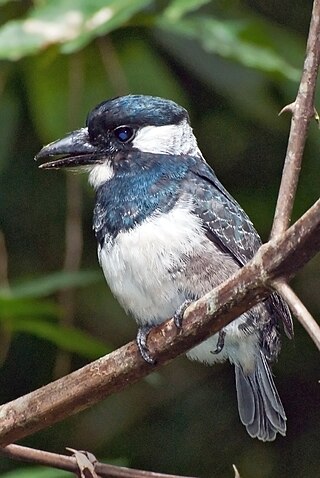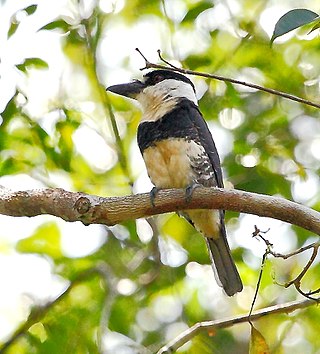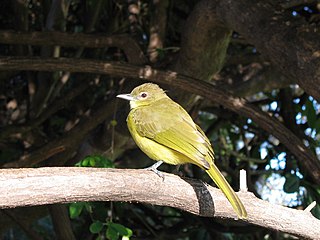
The bulbuls are members of a family, Pycnonotidae, of medium-sized passerine songbirds, which also includes greenbuls, brownbuls, leafloves, and bristlebills. The family is distributed across most of Africa and into the Middle East, tropical Asia to Indonesia, and north as far as Japan. A few insular species occur on the tropical islands of the Indian Ocean. There are 166 species in 32 genera. While different species are found in a wide range of habitats, the African species are predominantly found in rainforest, whereas Asian bulbuls are predominantly found in more open areas.

The greenbuls are a group of birds within the bulbul family Pycnonotidae, found only within Africa. They are all largely drab olive-green above, and paler below, with few distinguishing features.

Thlypopsis is a genus of birds in the tanager family Thraupidae.

Notharchus is a genus of puffbird in the Bucconidae family.

The Guianan puffbird is a species of bird in the family Bucconidae, the puffbirds, nunlets, and nunbirds. It is found in Brazil, French Guiana, Guyana, Suriname, and Venezuela. It was formerly considered to be conspecific with the white-necked puffbird and the buff-bellied puffbird with the English name "white-necked puffbird".

Nystalus is a genus of puffbirds in the family Bucconidae.

Arizelocichla is a genus of greenbuls, songbirds in the bulbul family (Pycnonotidae). The genus was revived in 2010 when twelve species of bulbuls from the genus Andropadus were separated and re-classified in the genus Arizelocichla.

The little greenbul is a species of the bulbul family of passerine birds. It is found in many parts of sub-Saharan Africa.

Sjöstedt's greenbul is a species of songbird in the bulbul family, Pycnonotidae. It is found in western and central Africa.

The honeyguide greenbul is a species of songbird in the bulbul family, Pycnonotidae. It is widespread throughout the African tropical rainforest.

Chlorocichla is a genus of songbird in the bulbul family, Pycnonotidae. They are mainly present throughout the African tropical rainforest, excepted the yellow-bellied greenbul, native to the miombo woodlands.

Criniger is a genus of songbirds in the bulbul family, Pycnonotidae. The species of Criniger are found in western and central Africa.

Phyllastrephus is a songbird genus in the bulbul family Pycnonotidae. Most of the species in the genus are typical greenbuls, though two are brownbuls, and one is a leaflove.

Cabanis's greenbul, also known as Cabanis's bulbul, is a species of songbird in the bulbul family, Pycnonotidae. It is found in east-central and south-central Africa. Its natural habitats are subtropical or tropical dry forest, subtropical or tropical moist lowland forest, subtropical or tropical moist montane forest, and subtropical or tropical moist shrubland.

Hemitriccus is a genus of small South American birds in the tyrant flycatcher family Tyrannidae. They are commonly known as tody-tyrants or bamboo tyrants, but the former name is also shared with several members of the genus Poecilotriccus. Several species from the genus Hemitriccus are very similar, and consequently best separated by their voice.

Myrmoborus is a genus of passerine birds in the antbird family, Thamnophilidae.

Percnostola is a genus of insectivorous passerine birds in the family Thamnophilidae.

Terenura is a genus of insectivorous passerine birds in the antbird family, Thamnophilidae.

Eurillas is a genus of greenbuls, passerine birds in the bulbul family Pycnonotidae.

The olive-headed greenbul is a species of the bulbul family of passerine birds. It is found in east Africa.



















